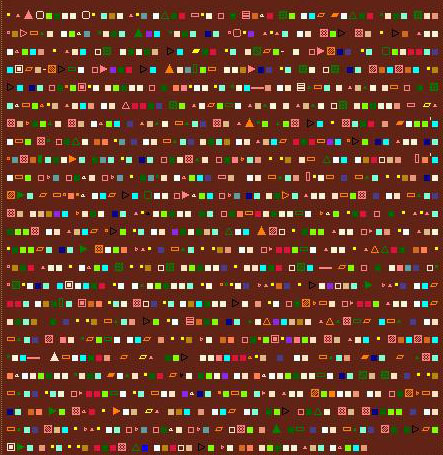It looks like you're using an Ad Blocker.
Please white-list or disable AboveTopSecret.com in your ad-blocking tool.
Thank you.
Some features of ATS will be disabled while you continue to use an ad-blocker.
share:
I want to look here at the 'coneheads' that created the worlds first civilizations, those of Sumeria and Elam, it is not generally known that the
group that founded what is often considered the worlds oldest city, Eridu, practised cranial deformation;
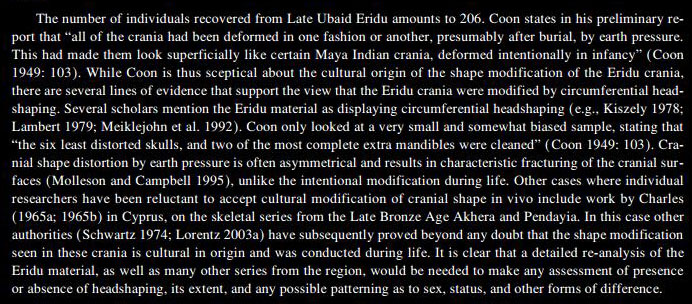
I'll be drawing on information primarily found in this series of articles relating to the Ubaid period;
Beyond the Ubaid
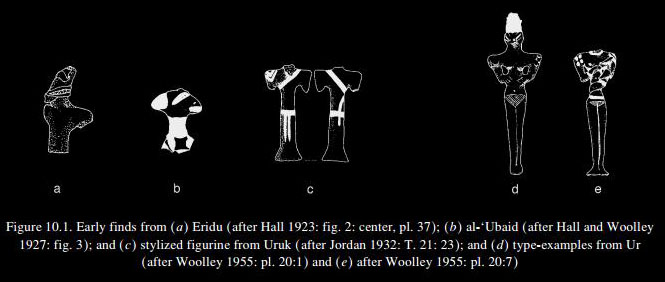
There is an almost seamless transition seen at Eridu between the Late Ubaid period and the rise of Sumerian culture, with earlier levels of the E-Abzu Temple of Enki dating back to the 5th Millennium, simply becoming ever larger and more elaborate.
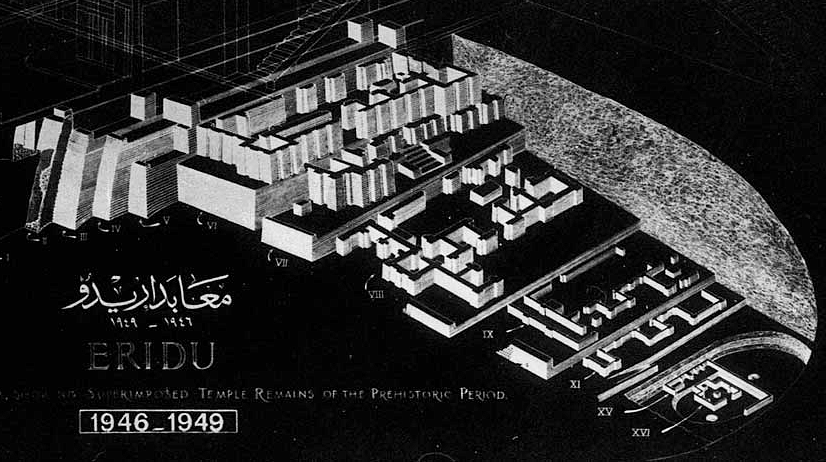
Actual photographs of such skulls are not as easy to come by as say for South America, due to age and states of preservation.

But the general method used in the Near East for the period was skull binding with bandages at infancy, rather than any usage of boards.

It is considered that the idealized form of the figurines directly relate to the cranial deformation practises of the people, that thus they represent themselves, or an idealized version of self.
It was only certain groups that carried out the practise, that set them aside from others.

It must be considered though that as these groups are as represented on the figurines, and that such would have a sacred context, then those who undertook cranial deformation were seen as in some way connected to the Divine, or the other-worldly.
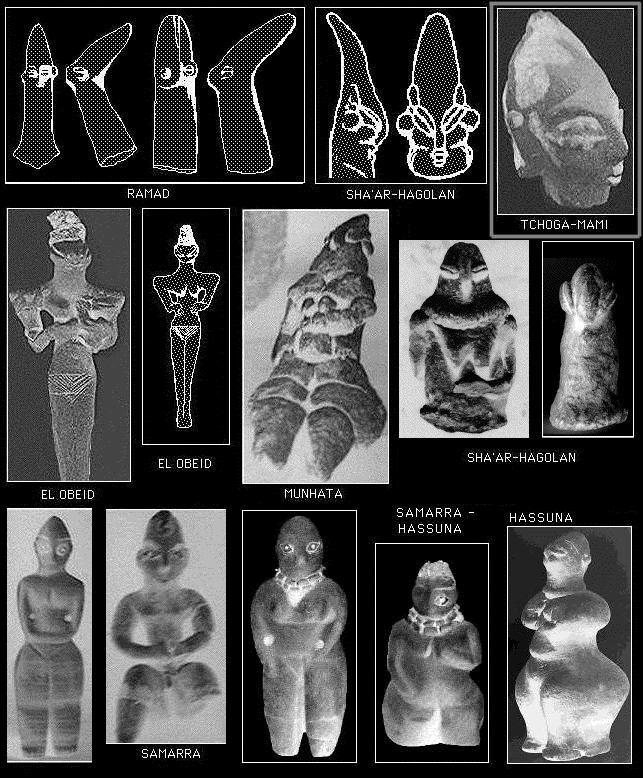
The geographical extent of Ubaid related cultures was considerable, extending into Iran, Syria and Turkey
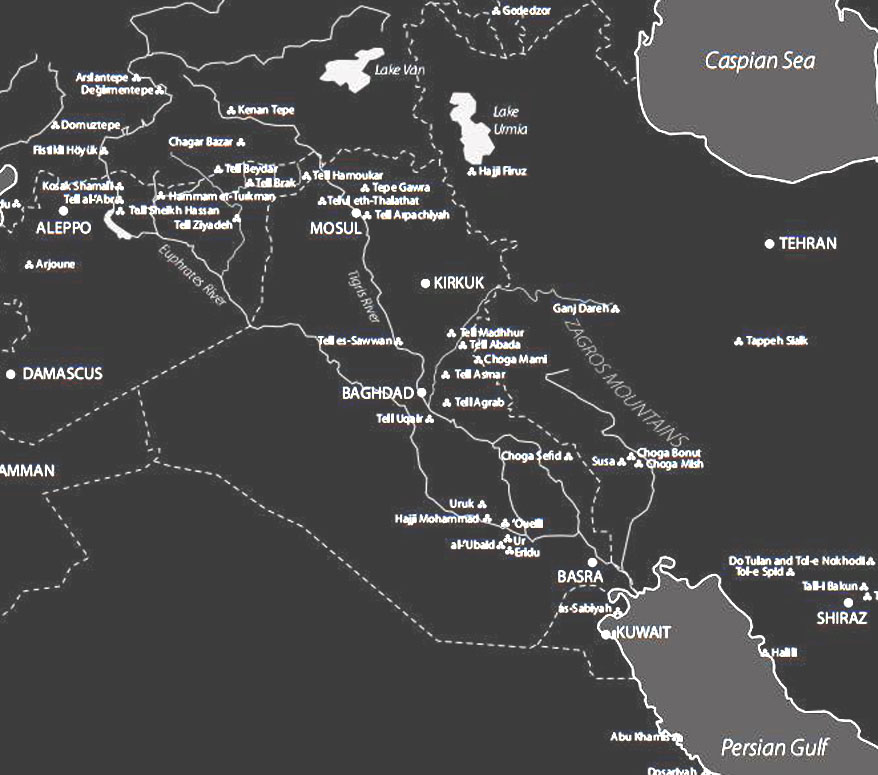
Whilst the Ubaid period is considered to focus on Southern Mesopotamia, from the 6th to the 5th Millenium Bc, the earlier and related Halaf period involved Northern Mesopotamia.
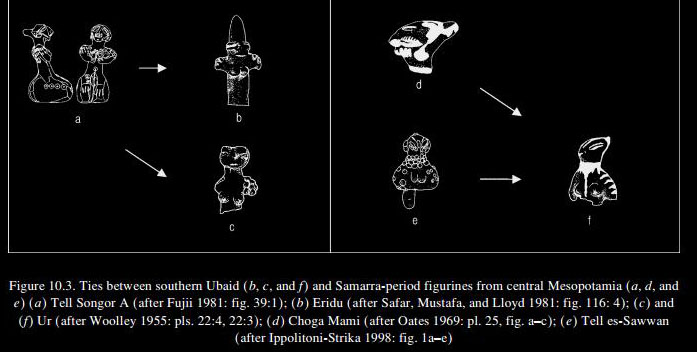
Cranial deformation is seen to have been widespread in all the Ubaid related cultures over this period, but in tracing back its origins this appears to be more centred on Iran, with examples dating back 11,000 years.
Pre-History of Iran...Artificial Cranial Deformations.
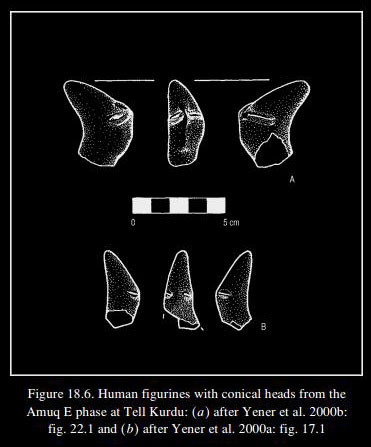
The Iranian skull deformations are again found within the greater context of figurines showing similar features and representations on pottery;

If the practise then was of emulation and the establishment of a particular identity, with relationship to the sacred, it can be seen it's origins would appear to trace back as far as the early Neolithic period, and that it went into effective decline at the end of the Ubaid period, and the rise of Sumerian and Elamite civilization, through perhaps a transference of the cultic practises into the cults of the Temple precincts.
But it can properly be said that it's adherents gave rise to the First Civilizations, and it might also be considered that a similar pattern emerged in South America and the rise of civilization there.

I'll be drawing on information primarily found in this series of articles relating to the Ubaid period;
Beyond the Ubaid

There is an almost seamless transition seen at Eridu between the Late Ubaid period and the rise of Sumerian culture, with earlier levels of the E-Abzu Temple of Enki dating back to the 5th Millennium, simply becoming ever larger and more elaborate.

Actual photographs of such skulls are not as easy to come by as say for South America, due to age and states of preservation.

But the general method used in the Near East for the period was skull binding with bandages at infancy, rather than any usage of boards.

It is considered that the idealized form of the figurines directly relate to the cranial deformation practises of the people, that thus they represent themselves, or an idealized version of self.
It was only certain groups that carried out the practise, that set them aside from others.

It must be considered though that as these groups are as represented on the figurines, and that such would have a sacred context, then those who undertook cranial deformation were seen as in some way connected to the Divine, or the other-worldly.

The geographical extent of Ubaid related cultures was considerable, extending into Iran, Syria and Turkey

Whilst the Ubaid period is considered to focus on Southern Mesopotamia, from the 6th to the 5th Millenium Bc, the earlier and related Halaf period involved Northern Mesopotamia.

Cranial deformation is seen to have been widespread in all the Ubaid related cultures over this period, but in tracing back its origins this appears to be more centred on Iran, with examples dating back 11,000 years.
Pre-History of Iran...Artificial Cranial Deformations.
At the settlement of Ganj Darra datable to the 9th-8th millennia BCE, from a total of 69 individuals (most of which were not complete), were recovered 14 skulls, all of which had been altered artificially through the use of bandages (Meiklejohn et al., p. 89). One of these crania is female and two are male; three others are probably female and five more probably male; three are of undetermined sex (Meiklejohn et al., p. 91, Table 4). The nearby 8th-millennium BCE settlement of Teppa Ghenil revealed remains of one individual of undetermined sex whose skull had been artificially modified, again using bandages (Meiklejohn et al., pp. 86-89; Hours et al., p. 138). From the broadly contemporary site of ʿAli Koš, at least three females of the 14 adult inhumations found beneath the houses displayed evidence of artificially modified skulls

The Iranian skull deformations are again found within the greater context of figurines showing similar features and representations on pottery;
In addition to figurines, further evidence can be gained from other depictions, such as representations of humans on pottery shreds, as recovered from the Neolithic site of Tell Sabi Abyad (Tall Ṣabi Abyaż) in Syria and the Chalcolithic site Tell Madhur in Mesopotamia (Molleson and Campbell, p. 52, fig. 9.4). Some samples of Iranian pottery also display humans with an elongated or exaggerated head shape, such as on shreds recovered from the Late Chalcolithic sites of Češma-ʿAli and Tall-e Bakun A (FIGURE 4). Whilst it is clear that in some cases the representations could demonstrate either cranial modification or more temporary alterations of hairstyle or wearing of headgear, what is nevertheless evident is the exaggeration and importance shown to the head, given prominence in certain portrayals during this particular period of Iranian prehistory.

If the practise then was of emulation and the establishment of a particular identity, with relationship to the sacred, it can be seen it's origins would appear to trace back as far as the early Neolithic period, and that it went into effective decline at the end of the Ubaid period, and the rise of Sumerian and Elamite civilization, through perhaps a transference of the cultic practises into the cults of the Temple precincts.
But it can properly be said that it's adherents gave rise to the First Civilizations, and it might also be considered that a similar pattern emerged in South America and the rise of civilization there.
edit on 16-8-2013 by Kantzveldt because: (no reason given)
Monkey see, monkey do. I think that the early people saw some people with real coneheads that impressed them so much that they started to band their
heads. I don't know if these original coneheads were human mutations or whether they were a different hominoid but I suspect that their intellect
was high enough to give them a respectful status sort of like we give Einstein.
reply to post by rickymouse
Yes we have certain individuals and groups that are created as 'coneheads' from birth and the question is why, was this a birthright down to genetics and ethnic identity, or status within the group, that has connections to the religious iconography and pre-eminent cultural statements.
The practise seems to date from the early Neolithic, and thus it can be questioned what role did the original 'coneheads' play in such, and who were they?
It can be seen at Eridu the centre of Ubaid culture that when a large grouping of 'coneheads' came together civilization resulted, so perhaps they were of higher intelligence and sophistication.
Yes we have certain individuals and groups that are created as 'coneheads' from birth and the question is why, was this a birthright down to genetics and ethnic identity, or status within the group, that has connections to the religious iconography and pre-eminent cultural statements.
The practise seems to date from the early Neolithic, and thus it can be questioned what role did the original 'coneheads' play in such, and who were they?
It can be seen at Eridu the centre of Ubaid culture that when a large grouping of 'coneheads' came together civilization resulted, so perhaps they were of higher intelligence and sophistication.
reply to post by Kantzveldt
I think it is more likely the opposite of what you are saying. That is, those cultures already practiced head binding/shaping and then the fallen chose the appearance that was already empowered by that culture. Same goes for all cultures, the fallen take form of whatever each culture has already empowered... If they were to come back today, they would look like brangelina.
I think it is more likely the opposite of what you are saying. That is, those cultures already practiced head binding/shaping and then the fallen chose the appearance that was already empowered by that culture. Same goes for all cultures, the fallen take form of whatever each culture has already empowered... If they were to come back today, they would look like brangelina.
reply to post by Bleeeeep
The evidence indicates (see my first link) that the spread of Ubaid related influence was not from conquest, or one group becoming dominant over another, but was achieved through peaceful transmission of ideas through trade contact.
There is nothing to indicate the 'coneheads' were ever in any way related to military force or a materially dominant culture, but rather they were associated with certain religious understandings and practises.
The evidence indicates (see my first link) that the spread of Ubaid related influence was not from conquest, or one group becoming dominant over another, but was achieved through peaceful transmission of ideas through trade contact.
There is nothing to indicate the 'coneheads' were ever in any way related to military force or a materially dominant culture, but rather they were associated with certain religious understandings and practises.
This is ATS so let's introduce an appropriate explanation....
The Nephilim who had children with women, their offspring...babies....would have come out deformed from the womb from being extraordinarily large sized and deforming their skulls from the birth canal. The non nephilim peoples tried to copy their appearance or the custom was forced/coerced upon them. The custom became traditional and was carried with tribes as they migrated the earth.
There now we have an ATS appropriate explanation.
The Nephilim who had children with women, their offspring...babies....would have come out deformed from the womb from being extraordinarily large sized and deforming their skulls from the birth canal. The non nephilim peoples tried to copy their appearance or the custom was forced/coerced upon them. The custom became traditional and was carried with tribes as they migrated the earth.
There now we have an ATS appropriate explanation.
My favorite Conehead was Akhenaten.
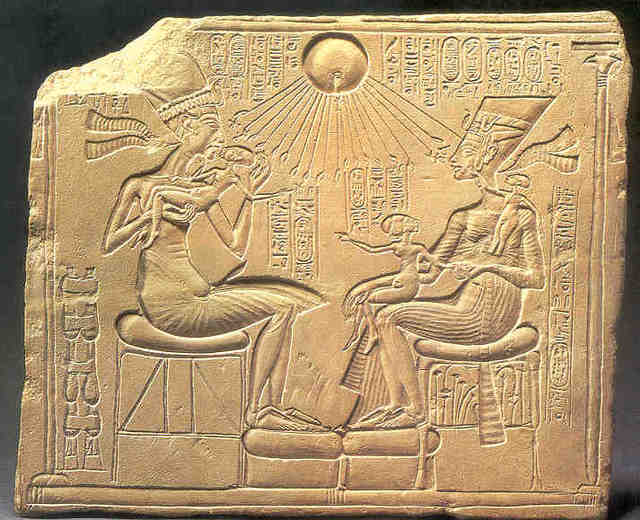
Do not let the headdresses fool you they were ornamental, and designed around his strangely shaped head. He was Not a product of head binding either.
Akhenaten comes on to the Egyptian Ruling scene in 1353 after Imhotep III. He ushers in a whole new religion and builds a new city designed for the worship of one go, the Aten. He throws out the previous pantheon and priests and tells them there is a new god in there world one who is above all others...
His family legacy still mystifies me and why did they try to erase it from history once he died?
It is more than obvious of how different looking his prodigy was as well.


Do not let the headdresses fool you they were ornamental, and designed around his strangely shaped head. He was Not a product of head binding either.
Akhenaten comes on to the Egyptian Ruling scene in 1353 after Imhotep III. He ushers in a whole new religion and builds a new city designed for the worship of one go, the Aten. He throws out the previous pantheon and priests and tells them there is a new god in there world one who is above all others...
His family legacy still mystifies me and why did they try to erase it from history once he died?
It is more than obvious of how different looking his prodigy was as well.

edit on 16-8-2013 by abeverage because: (no reason given)
edit on 16-8-2013 by abeverage because: (no
reason given)
It's also possible there existed a penis cult and these people were simply emulating the all powerful penis?
As above... etc. Though I favor the copying of god-like coneheads.
As above... etc. Though I favor the copying of god-like coneheads.
reply to post by abeverage
But what if the overall shape they were trying to emulate was based upon a mask, such as this from Eridu;
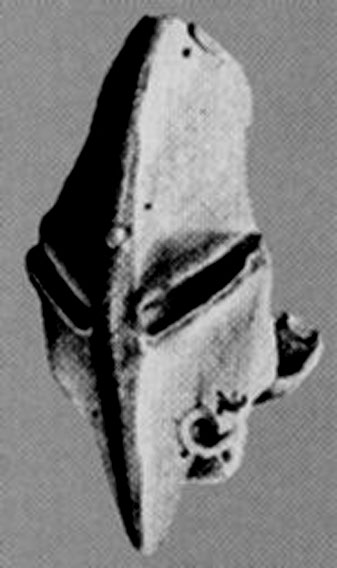
Vinca culture provides many examples of features that the Iranians developed into bird like figurines, with extended skulls, yet in Vinca figurines they always appear to be as a mask and costume.
Properly dressed aliens
Vinca Culture
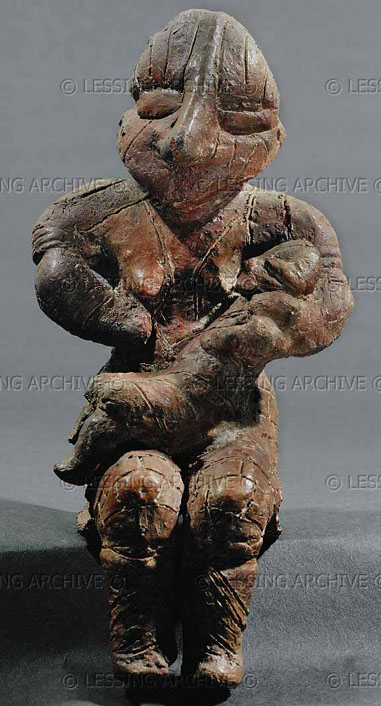
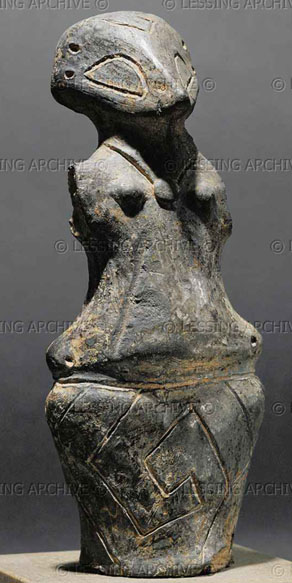

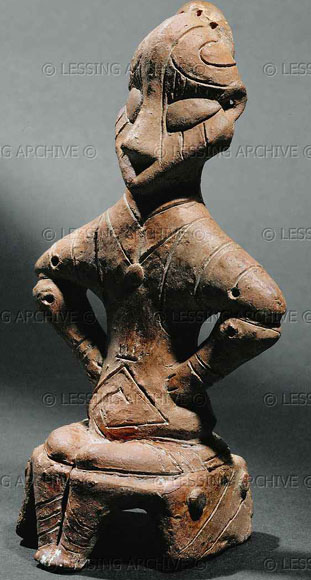
But what if the overall shape they were trying to emulate was based upon a mask, such as this from Eridu;

Vinca culture provides many examples of features that the Iranians developed into bird like figurines, with extended skulls, yet in Vinca figurines they always appear to be as a mask and costume.
Properly dressed aliens
Vinca Culture




edit on 16-8-2013 by Kantzveldt because: (no reason given)
reply to post by Kantzveldt
That's not what I meant by empowered - I meant closer to its common vernacular. "The speech was empowering."
You dress as the thing you inspire to be, not the thing which is controlled by your inspiration. You dress like a shaman not a warrior. If a culture worships animals and trees, you become the animals and trees - not the spears or rocks they fight with.
Think of each of the cultures who were visited. Each set of gods were different, not because there are many different gods (who are remarkably similar to animals of Earth), but because the gods chose to become the things the cultures highly regarded.
That's not what I meant by empowered - I meant closer to its common vernacular. "The speech was empowering."
You dress as the thing you inspire to be, not the thing which is controlled by your inspiration. You dress like a shaman not a warrior. If a culture worships animals and trees, you become the animals and trees - not the spears or rocks they fight with.
Think of each of the cultures who were visited. Each set of gods were different, not because there are many different gods (who are remarkably similar to animals of Earth), but because the gods chose to become the things the cultures highly regarded.
edit on 8/16/2013 by Bleeeeep because: (no
reason given)
Originally posted by Baddogma
It's also possible there existed a penis cult and these people were simply emulating the all powerful penis?
As above... etc. Though I favor the copying of god-like coneheads.
Well that was pretty random. I really doubt a penis cult has anything to do with head binding though
I think these were either outright Aliens or hybrids of human and alien as in the Nephilim. Of no doubt some where masks to emulate when a "god" left
or the genes lie dormant and appear within certain bloodlines first found (or created) within Sumeria/Mesopotamia that would then manifest every so
many generations.
Humans would try to emulate through costumes, masks and body modifications like headbinding in hopes of invoking them to return.
The Egyptian god Osirus ruler of the Underworld was always depicted with Green Skin and wearing The Atef Crown
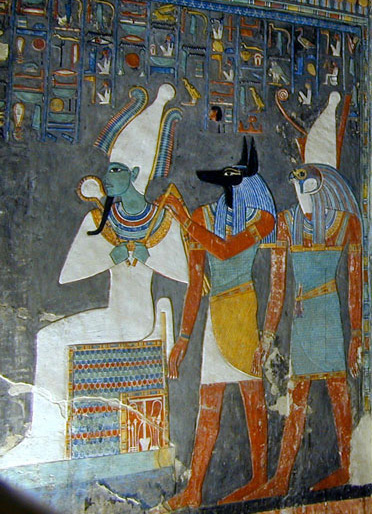
I love how the shimmering designs around the Atef are supposed to be ostrich feathers to me they look like some sort of energy.
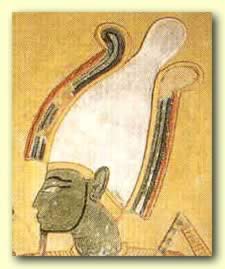
This Atef would fit perfectly over a Conehead and later all Egyptian Pharaohs would wear various types of the Atef in order of respect for the god and to try to emulate him.
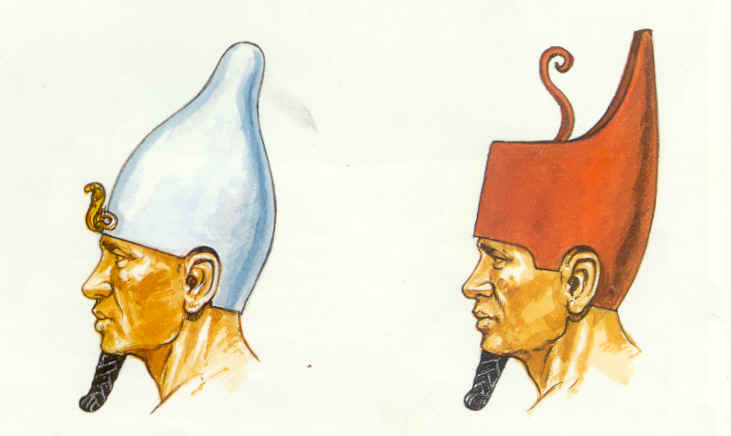
Not to detract from the Cones...
I am still wondering over the fake beard, if Osiris actually had one or if it was yet another strange appendage and the Egyptians due to all the laws of clean skin would wear fake ones to emulate it.
Humans would try to emulate through costumes, masks and body modifications like headbinding in hopes of invoking them to return.
The Egyptian god Osirus ruler of the Underworld was always depicted with Green Skin and wearing The Atef Crown

I love how the shimmering designs around the Atef are supposed to be ostrich feathers to me they look like some sort of energy.

This Atef would fit perfectly over a Conehead and later all Egyptian Pharaohs would wear various types of the Atef in order of respect for the god and to try to emulate him.

Not to detract from the Cones...
I am still wondering over the fake beard, if Osiris actually had one or if it was yet another strange appendage and the Egyptians due to all the laws of clean skin would wear fake ones to emulate it.
edit on 16-8-2013 by abeverage because: (no reason given)
reply to post by Kantzveldt
Wow, so it was the coneheads who built mysterious cities of rock. Can you imagine 3 or 4 coneheads standing around in prayer and meditation to lift the rocks supernaturally with their minds? I think reality is like that but reality is more of a dream world than we think.
Wow, so it was the coneheads who built mysterious cities of rock. Can you imagine 3 or 4 coneheads standing around in prayer and meditation to lift the rocks supernaturally with their minds? I think reality is like that but reality is more of a dream world than we think.
reply to post by Kantzveldt
this is a fascinating topic.
what does this mean, ...when a large group of "coneheads" came together civilization resulted,...
please, can you explain this with more details? which evidence is there that a large grouping of coneheads leads to civilisation?
this is a fascinating topic.
what does this mean, ...when a large group of "coneheads" came together civilization resulted,...
please, can you explain this with more details? which evidence is there that a large grouping of coneheads leads to civilisation?
reply to post by abeverage
It's perhaps more interesting to look at Pre-Dynastic Egyptian illustrations;
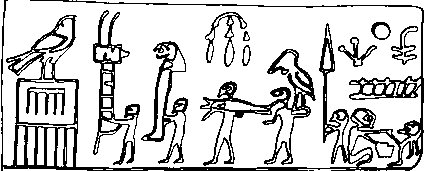
There we see figures which are taken as wearing masks, elongated skulls and bird like features. We can look at examples from Iran of an earlier date and see similar;
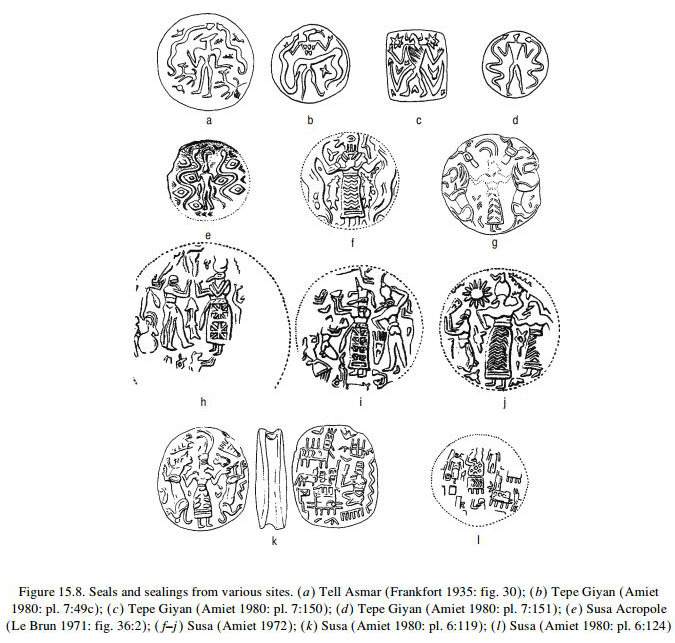
I would suggest that essentialy this is based on the full mask as best seen in the Vinca figurines, the elongated and sloping overall shape, the prominent nose piece, and rounded eye protection.
The coneheads were then probably looking to re-create through un-natural means the general overall proportions and sloped incline of the mask, and maintaining the traditions and teachings associated with it.
It's interesting to note on the vinca pieces there is no mouth represented, and thus the mask was to protect from the breathing of the air, the body suits offered full protection from the environment, as well as knee and elbow padding/protection, there is no explanation as to how such costume could be represented in the Mid-Neolithic period.
reply to post by lotusaugen
I was just saying there that of 206 late Ubaid period skulls found at Eridu, considered the worlds oldest city, all are now considered to have had artificial cranial deformations.
reply to post by Bleeeeep
Sure i'd generally agree with that, the propogation of inspiring ideas and traditions.
reply to post by abeverage
Well i did steal the idea for the thread from them...
The Ubaid...when the 'spread' from elsewhere does not work.
It's perhaps more interesting to look at Pre-Dynastic Egyptian illustrations;

There we see figures which are taken as wearing masks, elongated skulls and bird like features. We can look at examples from Iran of an earlier date and see similar;

I would suggest that essentialy this is based on the full mask as best seen in the Vinca figurines, the elongated and sloping overall shape, the prominent nose piece, and rounded eye protection.
The coneheads were then probably looking to re-create through un-natural means the general overall proportions and sloped incline of the mask, and maintaining the traditions and teachings associated with it.
It's interesting to note on the vinca pieces there is no mouth represented, and thus the mask was to protect from the breathing of the air, the body suits offered full protection from the environment, as well as knee and elbow padding/protection, there is no explanation as to how such costume could be represented in the Mid-Neolithic period.
reply to post by lotusaugen
I was just saying there that of 206 late Ubaid period skulls found at Eridu, considered the worlds oldest city, all are now considered to have had artificial cranial deformations.
reply to post by Bleeeeep
Sure i'd generally agree with that, the propogation of inspiring ideas and traditions.
reply to post by abeverage
Well i did steal the idea for the thread from them...
The Ubaid...when the 'spread' from elsewhere does not work.
edit on 16-8-2013 by Kantzveldt because: (no reason given)
reply to post by abeverage
His son tutankhaten (who later had his name changed to tutankhamun) reverted the religion back to the worship of amun and the old gods. Anyway the main point of this would be that since Akhenaten changed the religion he wasn't liked by many priests or people. So when Akhenaten died the heir was his son tutankhaten who was very young when he ruled. Meaning that his advisors most likely manipulated him in to reverting the religion and the majority of the records of Akhenaten would have been destroyed to prevent such things from happening over again.
His son tutankhaten (who later had his name changed to tutankhamun) reverted the religion back to the worship of amun and the old gods. Anyway the main point of this would be that since Akhenaten changed the religion he wasn't liked by many priests or people. So when Akhenaten died the heir was his son tutankhaten who was very young when he ruled. Meaning that his advisors most likely manipulated him in to reverting the religion and the majority of the records of Akhenaten would have been destroyed to prevent such things from happening over again.
It is quite fascinating.
What came first the Chicken or the Egg head?
Bird headed or Oblong skulls are a little too prominent
in too many cultures for me to say it was "Simply Fashion".
The bird people like Thoth or Quetzalcoatl,
are associated with knowledge.
Like math or agriculture and writing.
Who knows maybe a giant egg headed or bird headed creature did
teach us the basics and got us out of caves?
What came first the Chicken or the Egg head?
Bird headed or Oblong skulls are a little too prominent
in too many cultures for me to say it was "Simply Fashion".
The bird people like Thoth or Quetzalcoatl,
are associated with knowledge.
Like math or agriculture and writing.
Who knows maybe a giant egg headed or bird headed creature did
teach us the basics and got us out of caves?
Originally posted by blueyezblkdragon
reply to post by abeverage
His son tutankhaten (who later had his name changed to tutankhamun) reverted the religion back to the worship of amun and the old gods. Anyway the main point of this would be that since Akhenaten changed the religion he wasn't liked by many priests or people. So when Akhenaten died the heir was his son tutankhaten who was very young when he ruled. Meaning that his advisors most likely manipulated him in to reverting the religion and the majority of the records of Akhenaten would have been destroyed to prevent such things from happening over again.
We are all familiar with Tut honestly to the point of pulling interest away from his father...imho. I know the written history but it was not what I am looking for.
It still doesn't explain why he did it. Then why they changed it back (control most likely) Nor why he was different both physically and mental from most of the other Pharaohs!
Perhaps those genetic quirks allow different thinking into pushing their current society onto a different path.
edit on 16-8-2013 by abeverage
because: (no reason given)
reply to post by Kantzveldt
I think the picture of civilization is a lot more complicated than you're painting. It doesn't come from one source, but actually from five different centers that weren't in contact with each other.
en.wikipedia.org...
Cranial deformation's pretty neat, but there's more to it than that. The civilizations didn't just suddenly show up; they're built up from smaller things like tribes and villages.
I think the picture of civilization is a lot more complicated than you're painting. It doesn't come from one source, but actually from five different centers that weren't in contact with each other.
en.wikipedia.org...
Cranial deformation's pretty neat, but there's more to it than that. The civilizations didn't just suddenly show up; they're built up from smaller things like tribes and villages.
new topics
-
WATCH LIVE: US Congress hearing on UFOs, unidentified anomalous phenomena
Aliens and UFOs: 1 hours ago -
Worlds Behind You…
Short Stories: 1 hours ago -
Con Man Don
Jokes, Puns, & Pranks: 1 hours ago -
How can you defend yourself when the police will not tell you what you did?
Posse Comitatus: 5 hours ago
top topics
-
Elon's Starlink Stole The Election For Trump--Leftist Conspiracy Theorists Charge
General Conspiracies: 17 hours ago, 22 flags -
Speaker Johnson Orders Entire Biden Administration to Preserve and Retain All Records - Documents
US Political Madness: 17 hours ago, 20 flags -
Trump picks Gov. Kristi Noem to serve as homeland security secretary
2024 Elections: 14 hours ago, 14 flags -
How can you defend yourself when the police will not tell you what you did?
Posse Comitatus: 5 hours ago, 12 flags -
Worlds Behind You…
Short Stories: 1 hours ago, 3 flags -
WATCH LIVE: US Congress hearing on UFOs, unidentified anomalous phenomena
Aliens and UFOs: 1 hours ago, 3 flags -
Con Man Don
Jokes, Puns, & Pranks: 1 hours ago, 0 flags
active topics
-
Speaker Johnson Orders Entire Biden Administration to Preserve and Retain All Records - Documents
US Political Madness • 43 • : network dude -
President-Elect Donald Trump will Meet with Coup-Victim JOE BIDEN on Wed 11.13.2024.
2024 Elections • 24 • : xuenchen -
WATCH LIVE: US Congress hearing on UFOs, unidentified anomalous phenomena
Aliens and UFOs • 7 • : putnam6 -
Tomorrow will be the 7th day after the election, and they are still counting
US Political Madness • 41 • : awhispersecho -
The Trump effect 6 days after 2024 election
2024 Elections • 71 • : Vermilion -
Russia Ukraine Update Thread - part 3
World War Three • 6778 • : andy06shake -
Con Man Don
Jokes, Puns, & Pranks • 6 • : Myhandle -
Fired FEMA Employee Says It Was Not ‘Isolated’ Incident: ‘Colossal Event Of Avoidance’
US Political Madness • 38 • : DBCowboy -
Worlds Behind You…
Short Stories • 0 • : JJproductions -
How can you defend yourself when the police will not tell you what you did?
Posse Comitatus • 20 • : Shoshanna

